Research Methodologies: Quantitative, Qualitative, and Their Usage
VerifiedAdded on 2023/01/04
|9
|2508
|36
Essay
AI Summary
This essay provides a comprehensive overview of two primary research methodologies: quantitative and qualitative approaches. It begins with an introduction that highlights the inquisitive nature of humans and the role of research methodologies in satisfying curiosity. The essay then delves into the theoretical paradigms underlying these methodologies, differentiating between positivism (associated with quantitative research and objectivity) and interpretivism (associated with qualitative research and subjectivity). The main body further elaborates on the characteristics of each approach, including data collection methods, such as surveys (quantitative) and interpersonal methods (qualitative). The essay then reviews research papers in criminology, analyzing their use of quantitative and qualitative methods, sample sizes, and data collection strategies. The essay concludes by emphasizing that the choice of methodology depends on the nature of the research question, and both approaches have their strengths. A positivist view seeks objective understanding, while an interpretivist view dives into the subjective aspects to gain a broader understanding.

ASSIGNMENT
Paraphrase This Document
Need a fresh take? Get an instant paraphrase of this document with our AI Paraphraser

TABLE OF CONTENTS
INTRODUCTION......................................................................................................................3
MAIN BODY.............................................................................................................................3
Part I, Section 1......................................................................................................................3
Part I , Section 2.....................................................................................................................4
Part II......................................................................................................................................5
Title: Gendering Delinquent Networks..............................................................................5
Title: Do people comply with the law because they fear getting caught?.........................6
Title: Perceptions of antisocial behaviour and negative attitudes towards young people:
Focus group evidence from adult residents of disadvantaged urban neighbourhoods.......6
Title: What are the experiences of education for unaccompanied asylum‐seeking minors
in the UK?..........................................................................................................................6
General Comment..............................................................................................................7
CONCLUSION..........................................................................................................................8
References..................................................................................................................................9
INTRODUCTION......................................................................................................................3
MAIN BODY.............................................................................................................................3
Part I, Section 1......................................................................................................................3
Part I , Section 2.....................................................................................................................4
Part II......................................................................................................................................5
Title: Gendering Delinquent Networks..............................................................................5
Title: Do people comply with the law because they fear getting caught?.........................6
Title: Perceptions of antisocial behaviour and negative attitudes towards young people:
Focus group evidence from adult residents of disadvantaged urban neighbourhoods.......6
Title: What are the experiences of education for unaccompanied asylum‐seeking minors
in the UK?..........................................................................................................................6
General Comment..............................................................................................................7
CONCLUSION..........................................................................................................................8
References..................................................................................................................................9
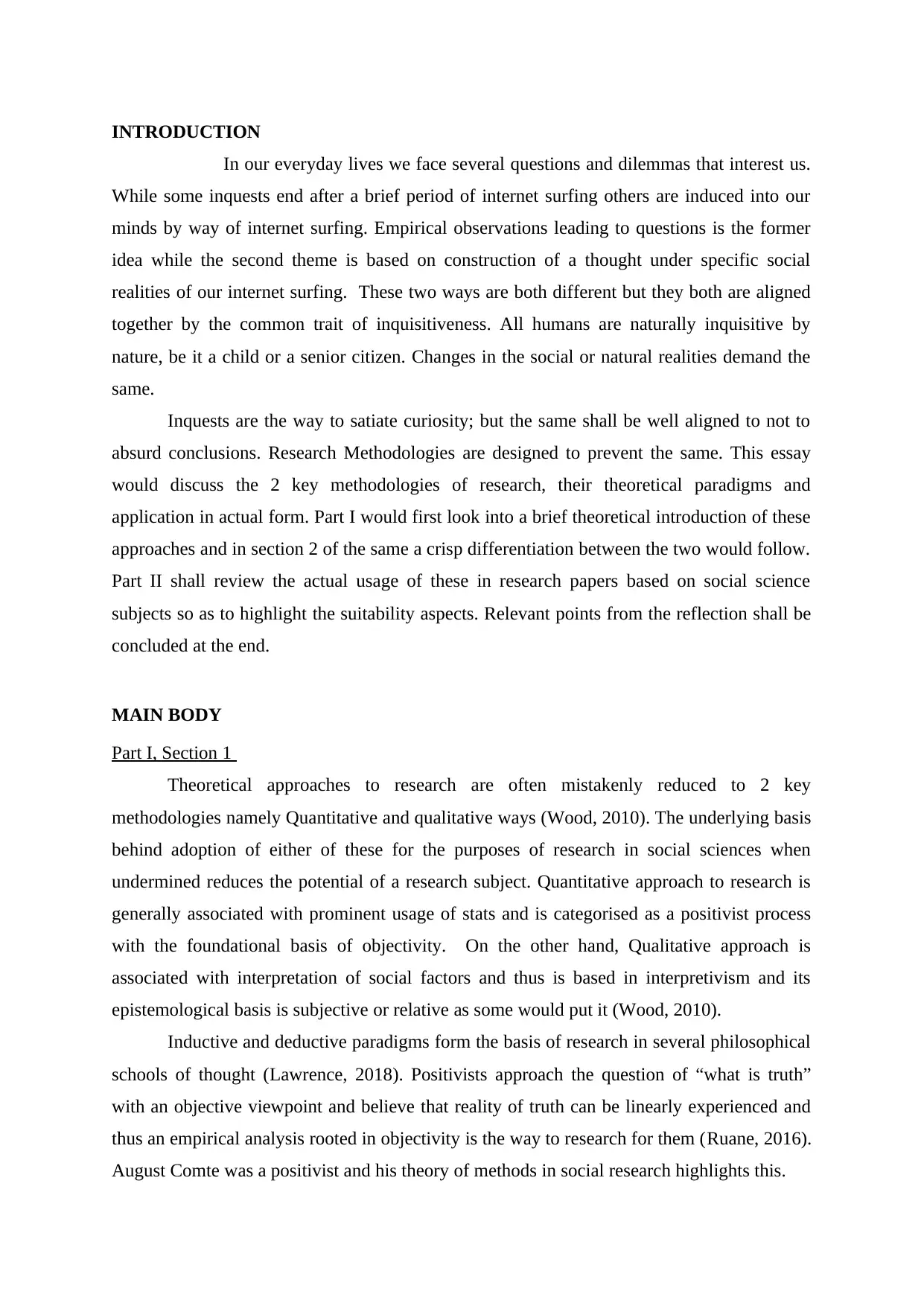
INTRODUCTION
In our everyday lives we face several questions and dilemmas that interest us.
While some inquests end after a brief period of internet surfing others are induced into our
minds by way of internet surfing. Empirical observations leading to questions is the former
idea while the second theme is based on construction of a thought under specific social
realities of our internet surfing. These two ways are both different but they both are aligned
together by the common trait of inquisitiveness. All humans are naturally inquisitive by
nature, be it a child or a senior citizen. Changes in the social or natural realities demand the
same.
Inquests are the way to satiate curiosity; but the same shall be well aligned to not to
absurd conclusions. Research Methodologies are designed to prevent the same. This essay
would discuss the 2 key methodologies of research, their theoretical paradigms and
application in actual form. Part I would first look into a brief theoretical introduction of these
approaches and in section 2 of the same a crisp differentiation between the two would follow.
Part II shall review the actual usage of these in research papers based on social science
subjects so as to highlight the suitability aspects. Relevant points from the reflection shall be
concluded at the end.
MAIN BODY
Part I, Section 1
Theoretical approaches to research are often mistakenly reduced to 2 key
methodologies namely Quantitative and qualitative ways (Wood, 2010). The underlying basis
behind adoption of either of these for the purposes of research in social sciences when
undermined reduces the potential of a research subject. Quantitative approach to research is
generally associated with prominent usage of stats and is categorised as a positivist process
with the foundational basis of objectivity. On the other hand, Qualitative approach is
associated with interpretation of social factors and thus is based in interpretivism and its
epistemological basis is subjective or relative as some would put it (Wood, 2010).
Inductive and deductive paradigms form the basis of research in several philosophical
schools of thought (Lawrence, 2018). Positivists approach the question of “what is truth”
with an objective viewpoint and believe that reality of truth can be linearly experienced and
thus an empirical analysis rooted in objectivity is the way to research for them (Ruane, 2016).
August Comte was a positivist and his theory of methods in social research highlights this.
In our everyday lives we face several questions and dilemmas that interest us.
While some inquests end after a brief period of internet surfing others are induced into our
minds by way of internet surfing. Empirical observations leading to questions is the former
idea while the second theme is based on construction of a thought under specific social
realities of our internet surfing. These two ways are both different but they both are aligned
together by the common trait of inquisitiveness. All humans are naturally inquisitive by
nature, be it a child or a senior citizen. Changes in the social or natural realities demand the
same.
Inquests are the way to satiate curiosity; but the same shall be well aligned to not to
absurd conclusions. Research Methodologies are designed to prevent the same. This essay
would discuss the 2 key methodologies of research, their theoretical paradigms and
application in actual form. Part I would first look into a brief theoretical introduction of these
approaches and in section 2 of the same a crisp differentiation between the two would follow.
Part II shall review the actual usage of these in research papers based on social science
subjects so as to highlight the suitability aspects. Relevant points from the reflection shall be
concluded at the end.
MAIN BODY
Part I, Section 1
Theoretical approaches to research are often mistakenly reduced to 2 key
methodologies namely Quantitative and qualitative ways (Wood, 2010). The underlying basis
behind adoption of either of these for the purposes of research in social sciences when
undermined reduces the potential of a research subject. Quantitative approach to research is
generally associated with prominent usage of stats and is categorised as a positivist process
with the foundational basis of objectivity. On the other hand, Qualitative approach is
associated with interpretation of social factors and thus is based in interpretivism and its
epistemological basis is subjective or relative as some would put it (Wood, 2010).
Inductive and deductive paradigms form the basis of research in several philosophical
schools of thought (Lawrence, 2018). Positivists approach the question of “what is truth”
with an objective viewpoint and believe that reality of truth can be linearly experienced and
thus an empirical analysis rooted in objectivity is the way to research for them (Ruane, 2016).
August Comte was a positivist and his theory of methods in social research highlights this.
⊘ This is a preview!⊘
Do you want full access?
Subscribe today to unlock all pages.

Trusted by 1+ million students worldwide
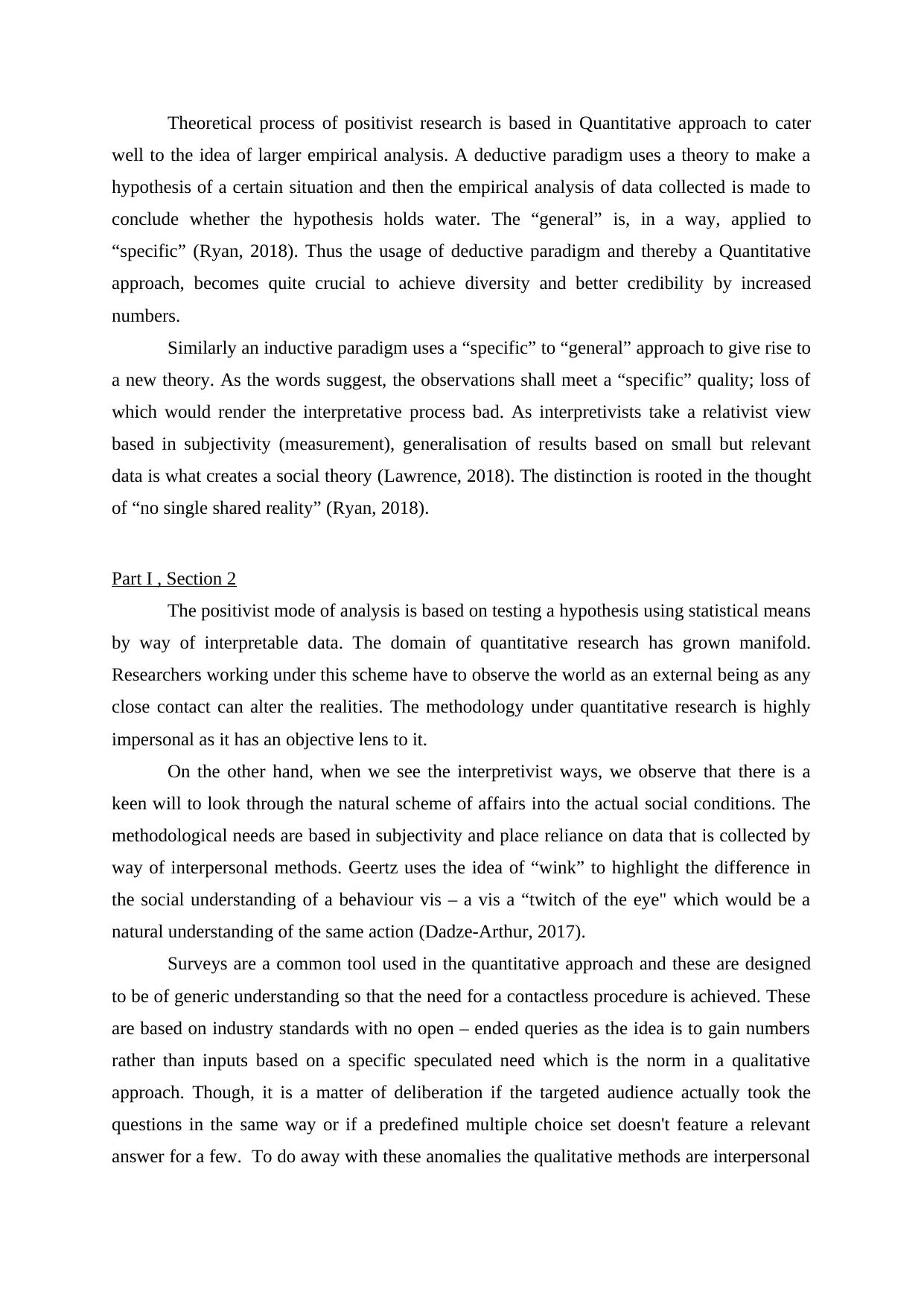
Theoretical process of positivist research is based in Quantitative approach to cater
well to the idea of larger empirical analysis. A deductive paradigm uses a theory to make a
hypothesis of a certain situation and then the empirical analysis of data collected is made to
conclude whether the hypothesis holds water. The “general” is, in a way, applied to
“specific” (Ryan, 2018). Thus the usage of deductive paradigm and thereby a Quantitative
approach, becomes quite crucial to achieve diversity and better credibility by increased
numbers.
Similarly an inductive paradigm uses a “specific” to “general” approach to give rise to
a new theory. As the words suggest, the observations shall meet a “specific” quality; loss of
which would render the interpretative process bad. As interpretivists take a relativist view
based in subjectivity (measurement), generalisation of results based on small but relevant
data is what creates a social theory (Lawrence, 2018). The distinction is rooted in the thought
of “no single shared reality” (Ryan, 2018).
Part I , Section 2
The positivist mode of analysis is based on testing a hypothesis using statistical means
by way of interpretable data. The domain of quantitative research has grown manifold.
Researchers working under this scheme have to observe the world as an external being as any
close contact can alter the realities. The methodology under quantitative research is highly
impersonal as it has an objective lens to it.
On the other hand, when we see the interpretivist ways, we observe that there is a
keen will to look through the natural scheme of affairs into the actual social conditions. The
methodological needs are based in subjectivity and place reliance on data that is collected by
way of interpersonal methods. Geertz uses the idea of “wink” to highlight the difference in
the social understanding of a behaviour vis – a vis a “twitch of the eye" which would be a
natural understanding of the same action (Dadze-Arthur, 2017).
Surveys are a common tool used in the quantitative approach and these are designed
to be of generic understanding so that the need for a contactless procedure is achieved. These
are based on industry standards with no open – ended queries as the idea is to gain numbers
rather than inputs based on a specific speculated need which is the norm in a qualitative
approach. Though, it is a matter of deliberation if the targeted audience actually took the
questions in the same way or if a predefined multiple choice set doesn't feature a relevant
answer for a few. To do away with these anomalies the qualitative methods are interpersonal
well to the idea of larger empirical analysis. A deductive paradigm uses a theory to make a
hypothesis of a certain situation and then the empirical analysis of data collected is made to
conclude whether the hypothesis holds water. The “general” is, in a way, applied to
“specific” (Ryan, 2018). Thus the usage of deductive paradigm and thereby a Quantitative
approach, becomes quite crucial to achieve diversity and better credibility by increased
numbers.
Similarly an inductive paradigm uses a “specific” to “general” approach to give rise to
a new theory. As the words suggest, the observations shall meet a “specific” quality; loss of
which would render the interpretative process bad. As interpretivists take a relativist view
based in subjectivity (measurement), generalisation of results based on small but relevant
data is what creates a social theory (Lawrence, 2018). The distinction is rooted in the thought
of “no single shared reality” (Ryan, 2018).
Part I , Section 2
The positivist mode of analysis is based on testing a hypothesis using statistical means
by way of interpretable data. The domain of quantitative research has grown manifold.
Researchers working under this scheme have to observe the world as an external being as any
close contact can alter the realities. The methodology under quantitative research is highly
impersonal as it has an objective lens to it.
On the other hand, when we see the interpretivist ways, we observe that there is a
keen will to look through the natural scheme of affairs into the actual social conditions. The
methodological needs are based in subjectivity and place reliance on data that is collected by
way of interpersonal methods. Geertz uses the idea of “wink” to highlight the difference in
the social understanding of a behaviour vis – a vis a “twitch of the eye" which would be a
natural understanding of the same action (Dadze-Arthur, 2017).
Surveys are a common tool used in the quantitative approach and these are designed
to be of generic understanding so that the need for a contactless procedure is achieved. These
are based on industry standards with no open – ended queries as the idea is to gain numbers
rather than inputs based on a specific speculated need which is the norm in a qualitative
approach. Though, it is a matter of deliberation if the targeted audience actually took the
questions in the same way or if a predefined multiple choice set doesn't feature a relevant
answer for a few. To do away with these anomalies the qualitative methods are interpersonal
Paraphrase This Document
Need a fresh take? Get an instant paraphrase of this document with our AI Paraphraser
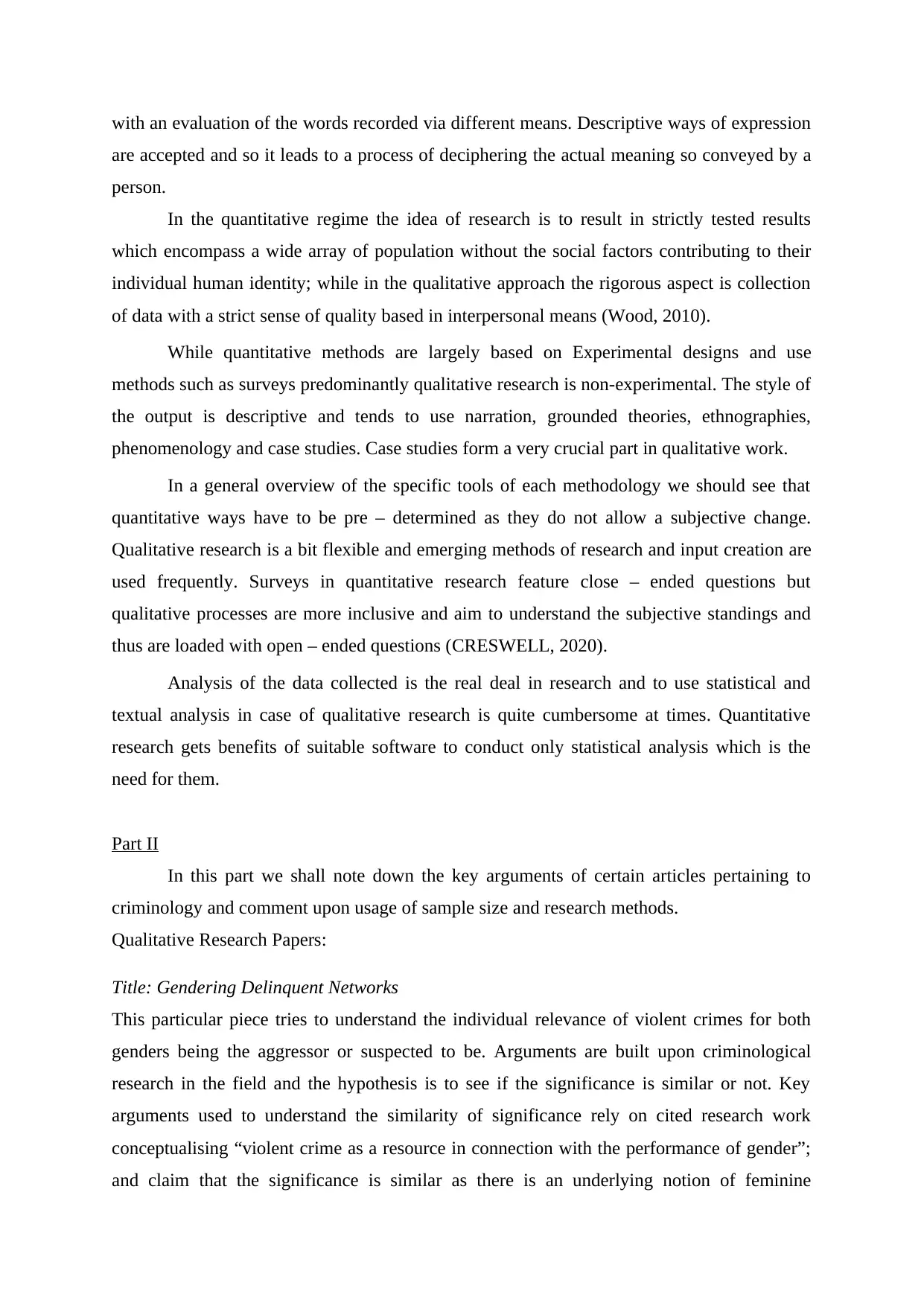
with an evaluation of the words recorded via different means. Descriptive ways of expression
are accepted and so it leads to a process of deciphering the actual meaning so conveyed by a
person.
In the quantitative regime the idea of research is to result in strictly tested results
which encompass a wide array of population without the social factors contributing to their
individual human identity; while in the qualitative approach the rigorous aspect is collection
of data with a strict sense of quality based in interpersonal means (Wood, 2010).
While quantitative methods are largely based on Experimental designs and use
methods such as surveys predominantly qualitative research is non-experimental. The style of
the output is descriptive and tends to use narration, grounded theories, ethnographies,
phenomenology and case studies. Case studies form a very crucial part in qualitative work.
In a general overview of the specific tools of each methodology we should see that
quantitative ways have to be pre – determined as they do not allow a subjective change.
Qualitative research is a bit flexible and emerging methods of research and input creation are
used frequently. Surveys in quantitative research feature close – ended questions but
qualitative processes are more inclusive and aim to understand the subjective standings and
thus are loaded with open – ended questions (CRESWELL, 2020).
Analysis of the data collected is the real deal in research and to use statistical and
textual analysis in case of qualitative research is quite cumbersome at times. Quantitative
research gets benefits of suitable software to conduct only statistical analysis which is the
need for them.
Part II
In this part we shall note down the key arguments of certain articles pertaining to
criminology and comment upon usage of sample size and research methods.
Qualitative Research Papers:
Title: Gendering Delinquent Networks
This particular piece tries to understand the individual relevance of violent crimes for both
genders being the aggressor or suspected to be. Arguments are built upon criminological
research in the field and the hypothesis is to see if the significance is similar or not. Key
arguments used to understand the similarity of significance rely on cited research work
conceptualising “violent crime as a resource in connection with the performance of gender”;
and claim that the significance is similar as there is an underlying notion of feminine
are accepted and so it leads to a process of deciphering the actual meaning so conveyed by a
person.
In the quantitative regime the idea of research is to result in strictly tested results
which encompass a wide array of population without the social factors contributing to their
individual human identity; while in the qualitative approach the rigorous aspect is collection
of data with a strict sense of quality based in interpersonal means (Wood, 2010).
While quantitative methods are largely based on Experimental designs and use
methods such as surveys predominantly qualitative research is non-experimental. The style of
the output is descriptive and tends to use narration, grounded theories, ethnographies,
phenomenology and case studies. Case studies form a very crucial part in qualitative work.
In a general overview of the specific tools of each methodology we should see that
quantitative ways have to be pre – determined as they do not allow a subjective change.
Qualitative research is a bit flexible and emerging methods of research and input creation are
used frequently. Surveys in quantitative research feature close – ended questions but
qualitative processes are more inclusive and aim to understand the subjective standings and
thus are loaded with open – ended questions (CRESWELL, 2020).
Analysis of the data collected is the real deal in research and to use statistical and
textual analysis in case of qualitative research is quite cumbersome at times. Quantitative
research gets benefits of suitable software to conduct only statistical analysis which is the
need for them.
Part II
In this part we shall note down the key arguments of certain articles pertaining to
criminology and comment upon usage of sample size and research methods.
Qualitative Research Papers:
Title: Gendering Delinquent Networks
This particular piece tries to understand the individual relevance of violent crimes for both
genders being the aggressor or suspected to be. Arguments are built upon criminological
research in the field and the hypothesis is to see if the significance is similar or not. Key
arguments used to understand the similarity of significance rely on cited research work
conceptualising “violent crime as a resource in connection with the performance of gender”;
and claim that the significance is similar as there is an underlying notion of feminine
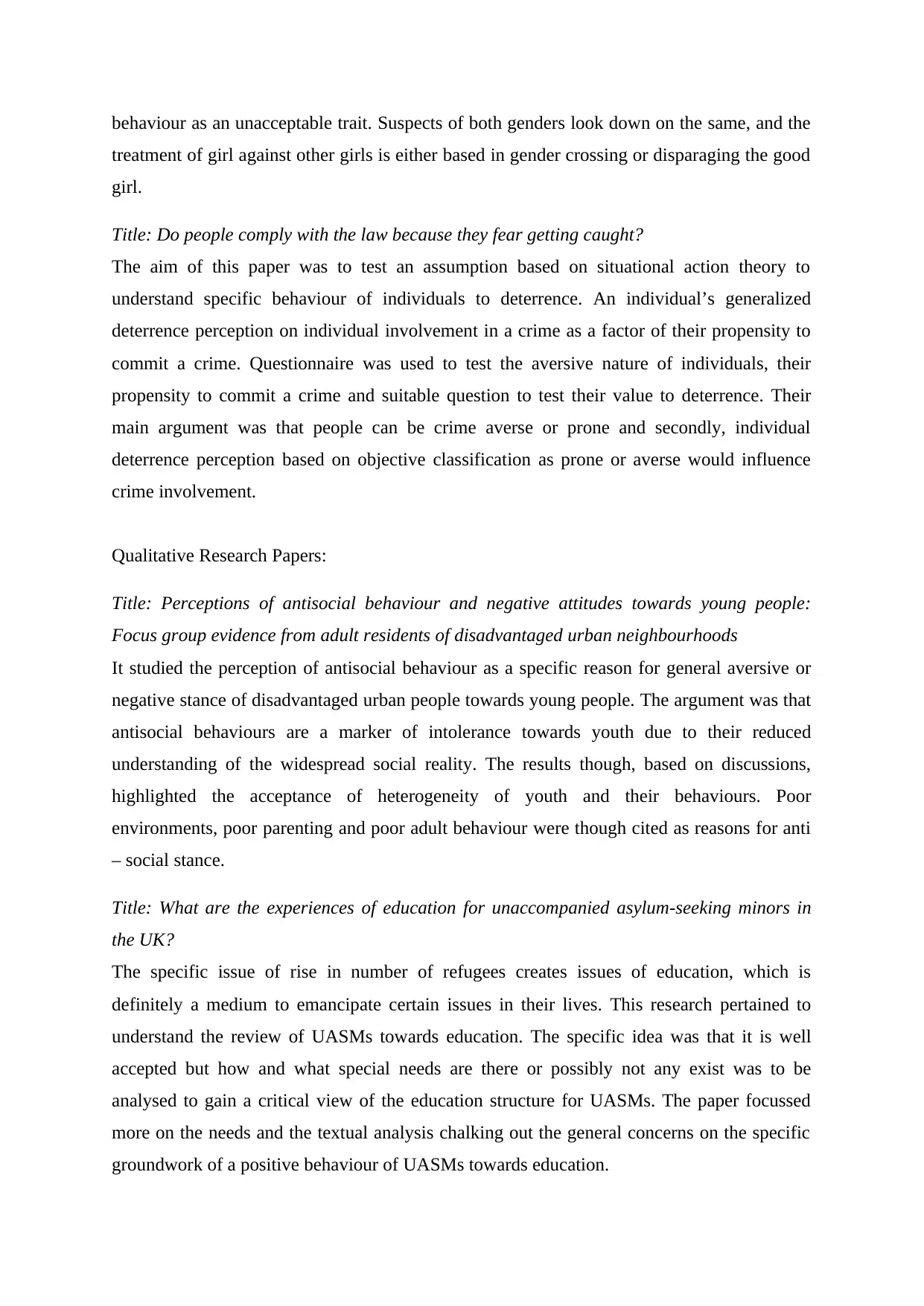
behaviour as an unacceptable trait. Suspects of both genders look down on the same, and the
treatment of girl against other girls is either based in gender crossing or disparaging the good
girl.
Title: Do people comply with the law because they fear getting caught?
The aim of this paper was to test an assumption based on situational action theory to
understand specific behaviour of individuals to deterrence. An individual’s generalized
deterrence perception on individual involvement in a crime as a factor of their propensity to
commit a crime. Questionnaire was used to test the aversive nature of individuals, their
propensity to commit a crime and suitable question to test their value to deterrence. Their
main argument was that people can be crime averse or prone and secondly, individual
deterrence perception based on objective classification as prone or averse would influence
crime involvement.
Qualitative Research Papers:
Title: Perceptions of antisocial behaviour and negative attitudes towards young people:
Focus group evidence from adult residents of disadvantaged urban neighbourhoods
It studied the perception of antisocial behaviour as a specific reason for general aversive or
negative stance of disadvantaged urban people towards young people. The argument was that
antisocial behaviours are a marker of intolerance towards youth due to their reduced
understanding of the widespread social reality. The results though, based on discussions,
highlighted the acceptance of heterogeneity of youth and their behaviours. Poor
environments, poor parenting and poor adult behaviour were though cited as reasons for anti
– social stance.
Title: What are the experiences of education for unaccompanied asylum‐seeking minors in
the UK?
The specific issue of rise in number of refugees creates issues of education, which is
definitely a medium to emancipate certain issues in their lives. This research pertained to
understand the review of UASMs towards education. The specific idea was that it is well
accepted but how and what special needs are there or possibly not any exist was to be
analysed to gain a critical view of the education structure for UASMs. The paper focussed
more on the needs and the textual analysis chalking out the general concerns on the specific
groundwork of a positive behaviour of UASMs towards education.
treatment of girl against other girls is either based in gender crossing or disparaging the good
girl.
Title: Do people comply with the law because they fear getting caught?
The aim of this paper was to test an assumption based on situational action theory to
understand specific behaviour of individuals to deterrence. An individual’s generalized
deterrence perception on individual involvement in a crime as a factor of their propensity to
commit a crime. Questionnaire was used to test the aversive nature of individuals, their
propensity to commit a crime and suitable question to test their value to deterrence. Their
main argument was that people can be crime averse or prone and secondly, individual
deterrence perception based on objective classification as prone or averse would influence
crime involvement.
Qualitative Research Papers:
Title: Perceptions of antisocial behaviour and negative attitudes towards young people:
Focus group evidence from adult residents of disadvantaged urban neighbourhoods
It studied the perception of antisocial behaviour as a specific reason for general aversive or
negative stance of disadvantaged urban people towards young people. The argument was that
antisocial behaviours are a marker of intolerance towards youth due to their reduced
understanding of the widespread social reality. The results though, based on discussions,
highlighted the acceptance of heterogeneity of youth and their behaviours. Poor
environments, poor parenting and poor adult behaviour were though cited as reasons for anti
– social stance.
Title: What are the experiences of education for unaccompanied asylum‐seeking minors in
the UK?
The specific issue of rise in number of refugees creates issues of education, which is
definitely a medium to emancipate certain issues in their lives. This research pertained to
understand the review of UASMs towards education. The specific idea was that it is well
accepted but how and what special needs are there or possibly not any exist was to be
analysed to gain a critical view of the education structure for UASMs. The paper focussed
more on the needs and the textual analysis chalking out the general concerns on the specific
groundwork of a positive behaviour of UASMs towards education.
⊘ This is a preview!⊘
Do you want full access?
Subscribe today to unlock all pages.

Trusted by 1+ million students worldwide

General Comment
While the qualitative researches looked at the scheme of affairs in numbers exceeding 1200
and 700 respectively, the sample size in the qualitative work was merely limited to 83 and 6
in number. These numbers are well suited to the needs and structure to the topics as well as
the general understanding of qualitative and quantitative memories. Looking at the strategies
of data collection it was highlighted that the modes were police reports and small-group
questionnaires plus one-to-one psychometric tests ( the ways were impersonal mostly)
respectively in the qualitative papers highly in contrast to focus group discussions and ideas
sought by way of one to one discussion and then analysed by IPA method. Detailed accounts
with subjective understanding made the data received suitable to the purpose.
While the qualitative researches looked at the scheme of affairs in numbers exceeding 1200
and 700 respectively, the sample size in the qualitative work was merely limited to 83 and 6
in number. These numbers are well suited to the needs and structure to the topics as well as
the general understanding of qualitative and quantitative memories. Looking at the strategies
of data collection it was highlighted that the modes were police reports and small-group
questionnaires plus one-to-one psychometric tests ( the ways were impersonal mostly)
respectively in the qualitative papers highly in contrast to focus group discussions and ideas
sought by way of one to one discussion and then analysed by IPA method. Detailed accounts
with subjective understanding made the data received suitable to the purpose.
Paraphrase This Document
Need a fresh take? Get an instant paraphrase of this document with our AI Paraphraser
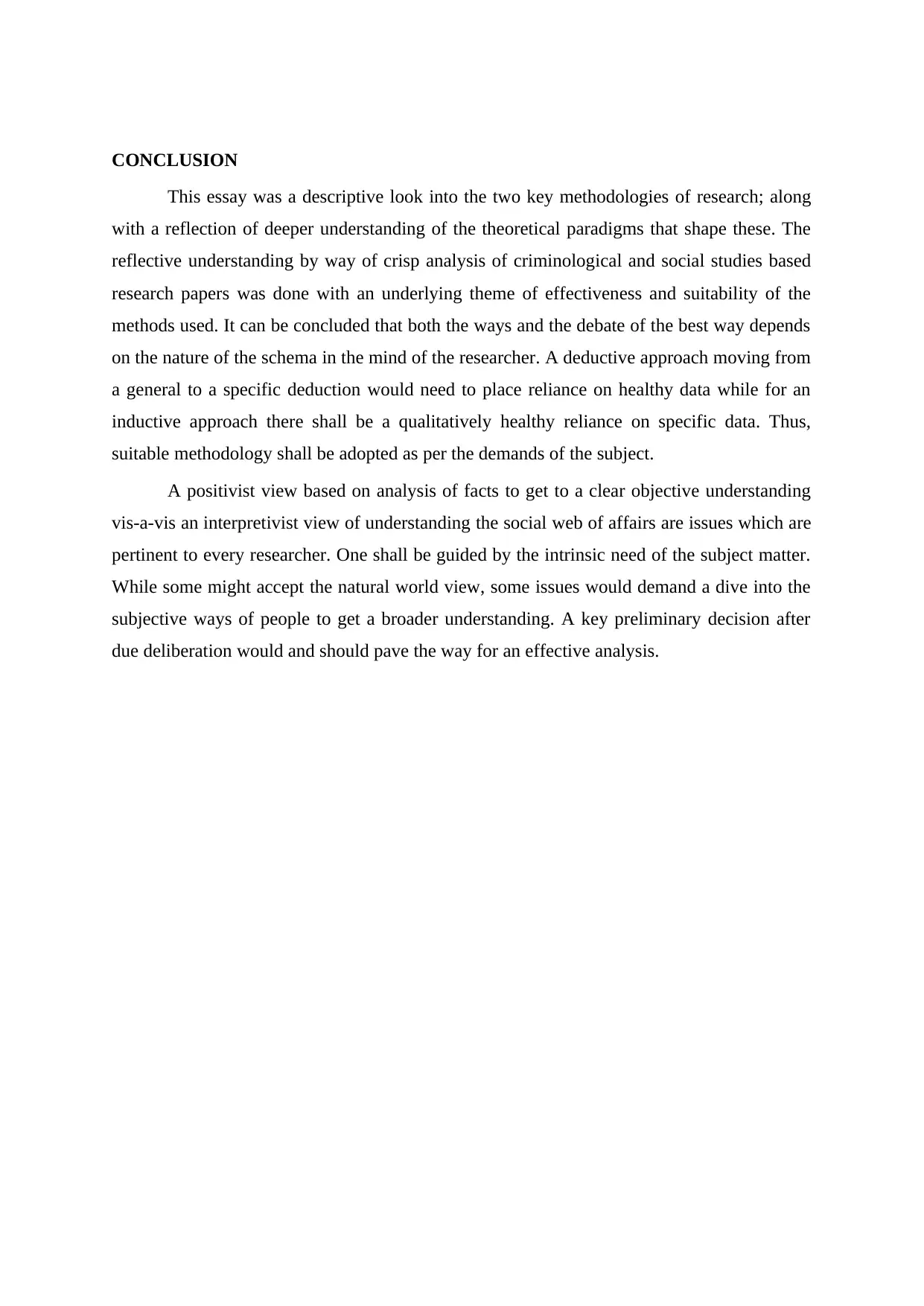
CONCLUSION
This essay was a descriptive look into the two key methodologies of research; along
with a reflection of deeper understanding of the theoretical paradigms that shape these. The
reflective understanding by way of crisp analysis of criminological and social studies based
research papers was done with an underlying theme of effectiveness and suitability of the
methods used. It can be concluded that both the ways and the debate of the best way depends
on the nature of the schema in the mind of the researcher. A deductive approach moving from
a general to a specific deduction would need to place reliance on healthy data while for an
inductive approach there shall be a qualitatively healthy reliance on specific data. Thus,
suitable methodology shall be adopted as per the demands of the subject.
A positivist view based on analysis of facts to get to a clear objective understanding
vis-a-vis an interpretivist view of understanding the social web of affairs are issues which are
pertinent to every researcher. One shall be guided by the intrinsic need of the subject matter.
While some might accept the natural world view, some issues would demand a dive into the
subjective ways of people to get a broader understanding. A key preliminary decision after
due deliberation would and should pave the way for an effective analysis.
This essay was a descriptive look into the two key methodologies of research; along
with a reflection of deeper understanding of the theoretical paradigms that shape these. The
reflective understanding by way of crisp analysis of criminological and social studies based
research papers was done with an underlying theme of effectiveness and suitability of the
methods used. It can be concluded that both the ways and the debate of the best way depends
on the nature of the schema in the mind of the researcher. A deductive approach moving from
a general to a specific deduction would need to place reliance on healthy data while for an
inductive approach there shall be a qualitatively healthy reliance on specific data. Thus,
suitable methodology shall be adopted as per the demands of the subject.
A positivist view based on analysis of facts to get to a clear objective understanding
vis-a-vis an interpretivist view of understanding the social web of affairs are issues which are
pertinent to every researcher. One shall be guided by the intrinsic need of the subject matter.
While some might accept the natural world view, some issues would demand a dive into the
subjective ways of people to get a broader understanding. A key preliminary decision after
due deliberation would and should pave the way for an effective analysis.
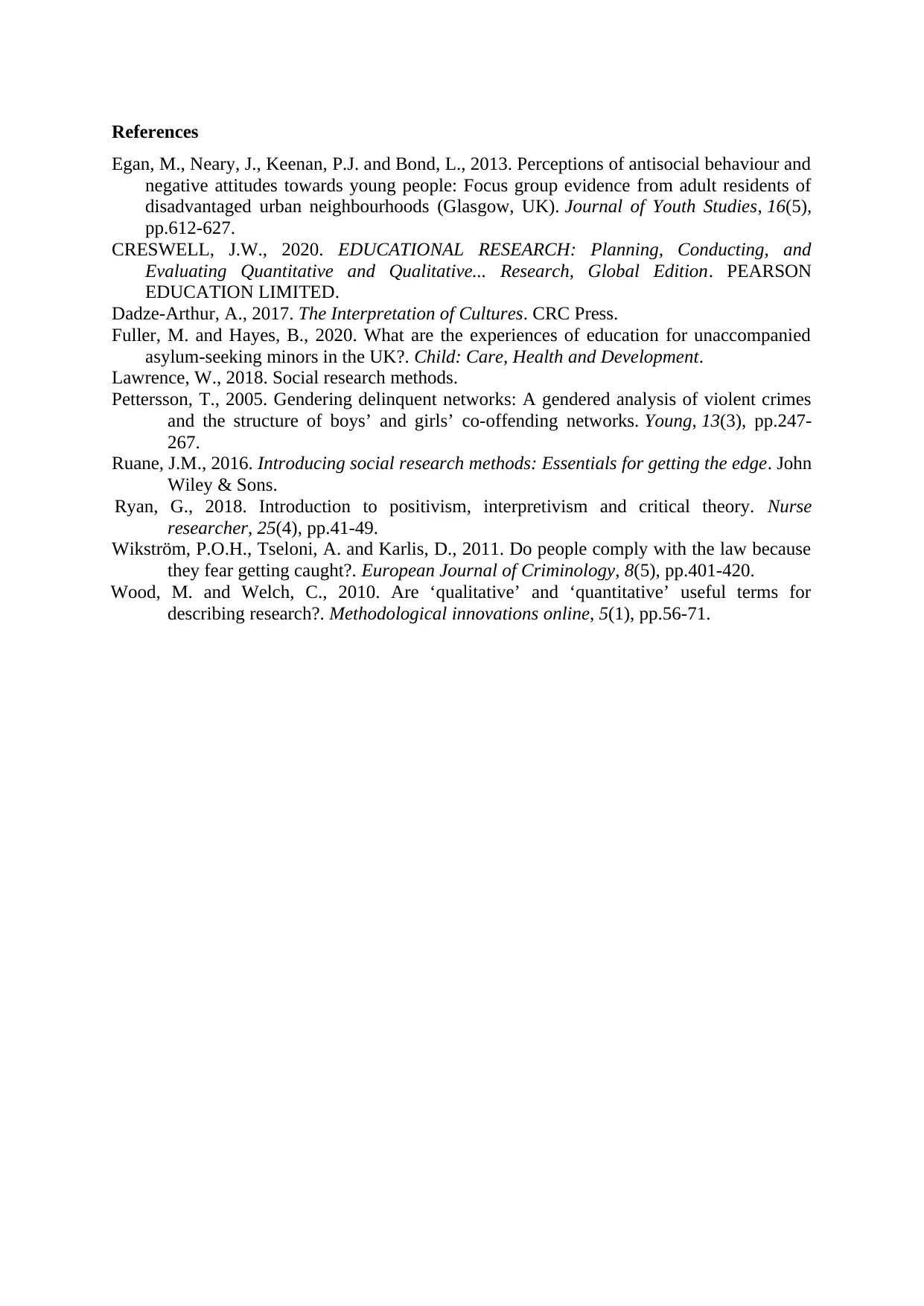
References
Egan, M., Neary, J., Keenan, P.J. and Bond, L., 2013. Perceptions of antisocial behaviour and
negative attitudes towards young people: Focus group evidence from adult residents of
disadvantaged urban neighbourhoods (Glasgow, UK). Journal of Youth Studies, 16(5),
pp.612-627.
CRESWELL, J.W., 2020. EDUCATIONAL RESEARCH: Planning, Conducting, and
Evaluating Quantitative and Qualitative... Research, Global Edition. PEARSON
EDUCATION LIMITED.
Dadze-Arthur, A., 2017. The Interpretation of Cultures. CRC Press.
Fuller, M. and Hayes, B., 2020. What are the experiences of education for unaccompanied
asylum‐seeking minors in the UK?. Child: Care, Health and Development.
Lawrence, W., 2018. Social research methods.
Pettersson, T., 2005. Gendering delinquent networks: A gendered analysis of violent crimes
and the structure of boys’ and girls’ co-offending networks. Young, 13(3), pp.247-
267.
Ruane, J.M., 2016. Introducing social research methods: Essentials for getting the edge. John
Wiley & Sons.
Ryan, G., 2018. Introduction to positivism, interpretivism and critical theory. Nurse
researcher, 25(4), pp.41-49.
Wikström, P.O.H., Tseloni, A. and Karlis, D., 2011. Do people comply with the law because
they fear getting caught?. European Journal of Criminology, 8(5), pp.401-420.
Wood, M. and Welch, C., 2010. Are ‘qualitative’ and ‘quantitative’ useful terms for
describing research?. Methodological innovations online, 5(1), pp.56-71.
Egan, M., Neary, J., Keenan, P.J. and Bond, L., 2013. Perceptions of antisocial behaviour and
negative attitudes towards young people: Focus group evidence from adult residents of
disadvantaged urban neighbourhoods (Glasgow, UK). Journal of Youth Studies, 16(5),
pp.612-627.
CRESWELL, J.W., 2020. EDUCATIONAL RESEARCH: Planning, Conducting, and
Evaluating Quantitative and Qualitative... Research, Global Edition. PEARSON
EDUCATION LIMITED.
Dadze-Arthur, A., 2017. The Interpretation of Cultures. CRC Press.
Fuller, M. and Hayes, B., 2020. What are the experiences of education for unaccompanied
asylum‐seeking minors in the UK?. Child: Care, Health and Development.
Lawrence, W., 2018. Social research methods.
Pettersson, T., 2005. Gendering delinquent networks: A gendered analysis of violent crimes
and the structure of boys’ and girls’ co-offending networks. Young, 13(3), pp.247-
267.
Ruane, J.M., 2016. Introducing social research methods: Essentials for getting the edge. John
Wiley & Sons.
Ryan, G., 2018. Introduction to positivism, interpretivism and critical theory. Nurse
researcher, 25(4), pp.41-49.
Wikström, P.O.H., Tseloni, A. and Karlis, D., 2011. Do people comply with the law because
they fear getting caught?. European Journal of Criminology, 8(5), pp.401-420.
Wood, M. and Welch, C., 2010. Are ‘qualitative’ and ‘quantitative’ useful terms for
describing research?. Methodological innovations online, 5(1), pp.56-71.
⊘ This is a preview!⊘
Do you want full access?
Subscribe today to unlock all pages.

Trusted by 1+ million students worldwide
1 out of 9
Your All-in-One AI-Powered Toolkit for Academic Success.
+13062052269
info@desklib.com
Available 24*7 on WhatsApp / Email
![[object Object]](/_next/static/media/star-bottom.7253800d.svg)
Unlock your academic potential
Copyright © 2020–2025 A2Z Services. All Rights Reserved. Developed and managed by ZUCOL.


